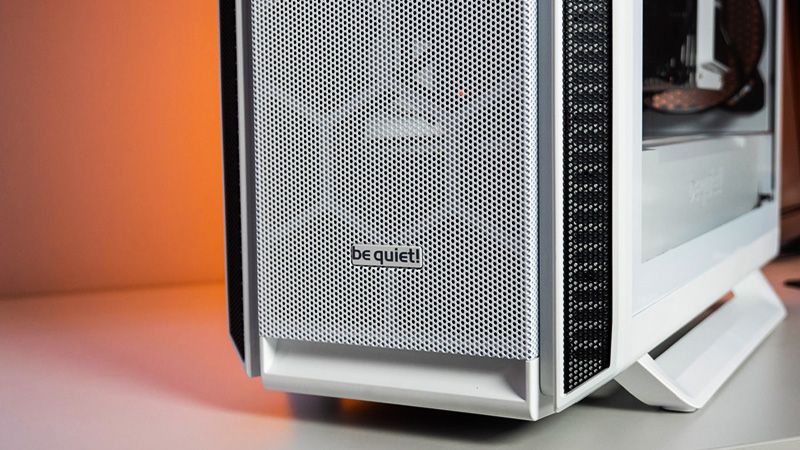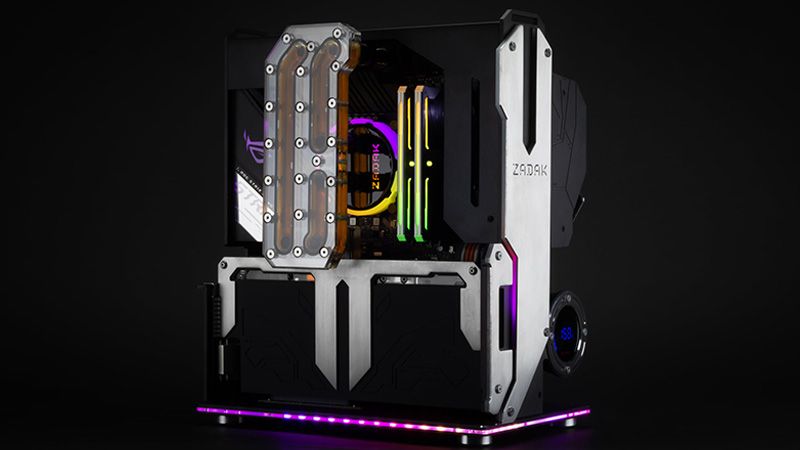Gigabyte X38-DQ6 vs Asus Maximus Formula
Το Χ38 είναι το πολυαναμενόμενο high end chipset της Intel το οποίο αναμένεται να κερδίσει τις καρδιές των απανταχού enthusiast. Ένα κύμα υλοποιήσεων αναμένεται να κατακλύσει την σύντομα αγορά και το δίλημμα που τίθεται είναι: Χ38 ναι, ποιάς εταιρίας όμως; Το Χ38 είναι το πολυαναμενόμενο high end chipset της Intel το οποίο αναμένεται να κερδίσει τις καρδιές των απανταχού enthusiast. Ένα κύμα υλοποιήσεων αναμένεται να κατακλύσει την σύντομα αγορά και το δίλημμα που τίθεται είναι: Χ38 ναι, ποιάς εταιρίας όμως;
Εδώ θα δούμε τις υλοποιήσεις των δυο μεγαλύτερων κατασκευαστών μητρικών πλακετών: του Χ38-DQ6 της Gigabyte και του Maximus Formula της ASUS. Και τα δύο βασίζονται στο Χ38 αυτό όμως δε σημαίνει πως αποδίδουν/συμπεριφέρονται με τον ίδιο τρόπο...

ASUS MAXIMUS FORMULA
[SIZE=2]
Clear CMOS the easy way...

[/SIZE]8 Power Phase design...

Υδρόψυξη για το NB...


Dual Phase PWM for vDIMM...

Στην Maximus Formula υπάρχουν LEDs για κεντρικά συστατικά της μητρικής (vcore, vdimm, vmch,) τα οποία ανάβουν όταν η τάση βρίσκεται εντός συγκεκριμένων ορίων...
CPU Vcore LED...

Northbridge Voltage LED...

VDimm Voltage LED...

Southbridge Voltage LED...

Το BIOS της Maximus...







Gigabyte X38-DQ6
[SIZE=2]

[/SIZE]Quad Triple Phase power regulators...

Heat pipe solutions for the Mosfets, Northbridge and Southbridge...

Crazy cool heat fins...

DQ6 BIOS shots...
[SIZE=2]









Pre testing...

[/SIZE] Benchmarking - 3DMark 06, PC Mark 05, Company of Heroes, Win RAR and SuperPi 8M
PCMark 05:

3DMark 06:

WinRAR Benchmark Tool:

SUPERPI 8M:

Company of Heroes:

Overclocking
In our overclocking test, we aim to find out the highest FSB achievable, using a duo core and a quad core CPU Chip, the Intel Core 2 Duo E6550 and the Core 2 Extreme QX6850.
Using the E6550 chip, we are able to push the FSB to 484Mhz on the ASUS Maximus Formula.

Using the Core 2 Quad Extreme QX6850, we are able to achieve a fsb of 460Mhz on the Maximus Formula.

Now heading over to the Gigabyte board, we use the Easy Tune setup and bump the fsb up to 480Mhz with the E6550 on the DQ6.

Now using the Core 2 Quad Extreme QX6850, we push the fsb to 475Mhz using the DQ6.

Conclusion - The Maximus or the X-38 DQ6???
[ Διαβάστε περισσότερα εδώ...]
Εδώ θα δούμε τις υλοποιήσεις των δυο μεγαλύτερων κατασκευαστών μητρικών πλακετών: του Χ38-DQ6 της Gigabyte και του Maximus Formula της ASUS. Και τα δύο βασίζονται στο Χ38 αυτό όμως δε σημαίνει πως αποδίδουν/συμπεριφέρονται με τον ίδιο τρόπο...

ASUS MAXIMUS FORMULA
[SIZE=2]

Clear CMOS the easy way...

[/SIZE]8 Power Phase design...

Υδρόψυξη για το NB...


Dual Phase PWM for vDIMM...

Στην Maximus Formula υπάρχουν LEDs για κεντρικά συστατικά της μητρικής (vcore, vdimm, vmch,) τα οποία ανάβουν όταν η τάση βρίσκεται εντός συγκεκριμένων ορίων...
CPU Vcore LED...

Northbridge Voltage LED...

VDimm Voltage LED...

Southbridge Voltage LED...

Το BIOS της Maximus...







Gigabyte X38-DQ6
[SIZE=2]

[/SIZE]Quad Triple Phase power regulators...

Heat pipe solutions for the Mosfets, Northbridge and Southbridge...

Crazy cool heat fins...

DQ6 BIOS shots...
[SIZE=2]










Pre testing...

[/SIZE] Benchmarking - 3DMark 06, PC Mark 05, Company of Heroes, Win RAR and SuperPi 8M
PCMark 05:

3DMark 06:

WinRAR Benchmark Tool:

SUPERPI 8M:

Company of Heroes:

Overclocking
In our overclocking test, we aim to find out the highest FSB achievable, using a duo core and a quad core CPU Chip, the Intel Core 2 Duo E6550 and the Core 2 Extreme QX6850.
Using the E6550 chip, we are able to push the FSB to 484Mhz on the ASUS Maximus Formula.

Using the Core 2 Quad Extreme QX6850, we are able to achieve a fsb of 460Mhz on the Maximus Formula.

Now heading over to the Gigabyte board, we use the Easy Tune setup and bump the fsb up to 480Mhz with the E6550 on the DQ6.

Now using the Core 2 Quad Extreme QX6850, we push the fsb to 475Mhz using the DQ6.

Conclusion - The Maximus or the X-38 DQ6???
Disse:
The Gigabyte actually commands a higher stock FSB compared to the Maximus! However, we are unsure whether the issue is with the board as we do not have other X38 boards to compare these 2 boards against at the moment. Overclocking headroom on the Gigabyte board looks promising though, with such an extensive variety of voltage options which you probably may not use and higher grade electronic components used to ensure a leading edge, with proper cooling we believe this board would have potential to scale to greater heights.
On the performance side, enthusiast may take the liking to the Maximus, judging from the benchmark results. Although we received just the board alone, albeit the initial release of the bios, we believe that newer revisions would eventually help in churning our higher performance figures from the maximus. Overclocking however could be improved although the newer BIOSes are still undisclosed. What makes the maximus standout? ASUS Republic of games have devised ingenious solutions such as clearing CMOSes with a touch of button at the I/O panel, LED voltage indications, watercooling extensible cooling northbridge, etc. At the same time, we should not forget the SupremeFX Sound attachment... You indeed are paying for a work of art.
I am definitely not inclined to place the Gigabyte board below that of the Maximus, with it's impressive slew of features and connectivity options onboard, and I'm very sure that the FAE team at Gigabyte will be tweaking the BIOS for better performance in time to come. As for the Maximus, with an impressive heatpipe-based heatsink for the chipset, some very innovative features for the overclocker, especially the voltage LED indication. The differences in overclockability between the two boards isn't too far apart considering that both boards has its strength, and it seems pretty evident that Gigabyte's triple quad PWM seems really efficient with Quad Cores. At the end of the day, one might have a really hard time choosing between this two boards.
The Gigabyte actually commands a higher stock FSB compared to the Maximus! However, we are unsure whether the issue is with the board as we do not have other X38 boards to compare these 2 boards against at the moment. Overclocking headroom on the Gigabyte board looks promising though, with such an extensive variety of voltage options which you probably may not use and higher grade electronic components used to ensure a leading edge, with proper cooling we believe this board would have potential to scale to greater heights.
On the performance side, enthusiast may take the liking to the Maximus, judging from the benchmark results. Although we received just the board alone, albeit the initial release of the bios, we believe that newer revisions would eventually help in churning our higher performance figures from the maximus. Overclocking however could be improved although the newer BIOSes are still undisclosed. What makes the maximus standout? ASUS Republic of games have devised ingenious solutions such as clearing CMOSes with a touch of button at the I/O panel, LED voltage indications, watercooling extensible cooling northbridge, etc. At the same time, we should not forget the SupremeFX Sound attachment... You indeed are paying for a work of art.
I am definitely not inclined to place the Gigabyte board below that of the Maximus, with it's impressive slew of features and connectivity options onboard, and I'm very sure that the FAE team at Gigabyte will be tweaking the BIOS for better performance in time to come. As for the Maximus, with an impressive heatpipe-based heatsink for the chipset, some very innovative features for the overclocker, especially the voltage LED indication. The differences in overclockability between the two boards isn't too far apart considering that both boards has its strength, and it seems pretty evident that Gigabyte's triple quad PWM seems really efficient with Quad Cores. At the end of the day, one might have a really hard time choosing between this two boards.
[ Διαβάστε περισσότερα εδώ...]
















